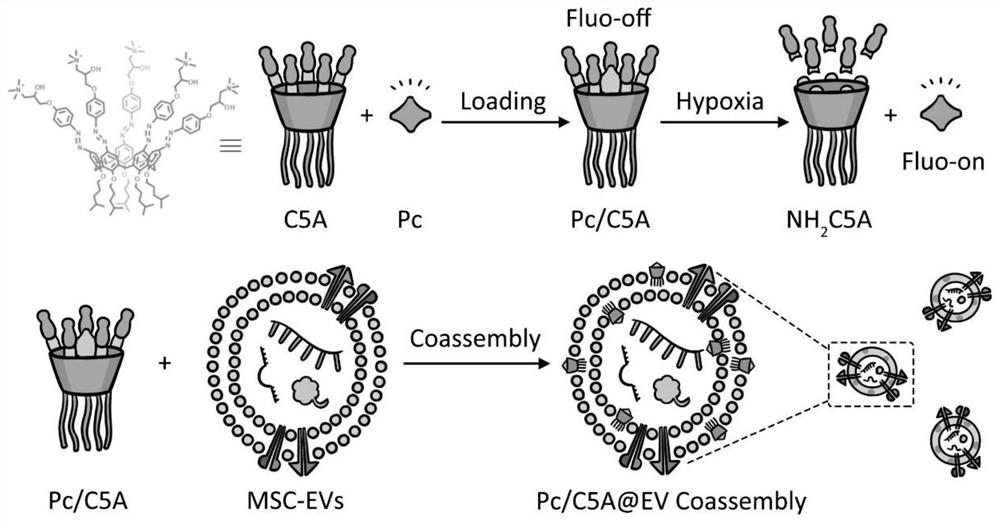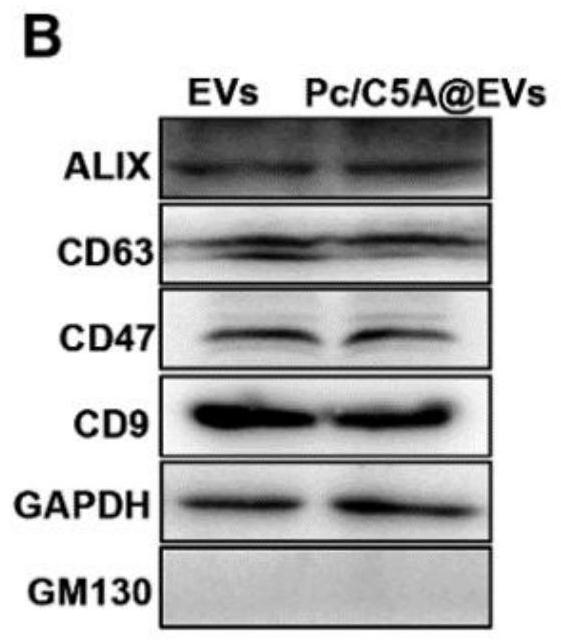Hypoxia response co-assembly system based on extracellular vesicles and preparation method thereof
A technology of co-assembly and vesicles, applied in the biological field, can solve the problems of inconvenient use, body damage, complex space for special equipment, etc.
- Summary
- Abstract
- Description
- Claims
- Application Information
AI Technical Summary
Problems solved by technology
Method used
Image
Examples
Embodiment 1
[0075] This example is used to illustrate a method for extracting extracellular vesicles derived from umbilical cord-derived mesenchymal stem cells.
[0076] The processing steps are as follows: place the fetal bovine serum in an ultracentrifuge tube, centrifuge at 100,000 g at 4°C for 2 hours, take the supernatant in an ultra-clean bench, filter it with a 0.22 μm needle filter, and store it in a -80°C refrigerator for later use.
[0077] See "Animal Cell Culture (Sixth Edition)" for details on the operation steps of cell biology experiments such as cell subculture, cryopreservation and recovery.
[0078] Collect the conditioned medium of human umbilical cord-derived mesenchymal stem cells (hP-MSCs) containing extracellular vesicles: when cultured in 75cm 2 The hP-MSCs in the cell culture flask are in the logarithmic growth phase. When the confluence of the cells reaches 80%, the medium is aspirated, washed twice with PBS, and 10ml of prepared 10% extracellular vesicle-free F...
Embodiment 2
[0085] This example is used to illustrate a method for preparing a co-assembly system based on extracellular vesicles (EVs) for hypoxia response imaging.
[0086] (1) After mixing aluminum phthalocyanine Pc and calixarene C5A respectively, incubate in a dark room at 37°C for 30 minutes.
[0087] (2) Add Pc / C5A to the extracted 100 μL EVs sample containing 200-300 μg protein, and make up to 500 μL with PBS. At this time, the final concentration of Pc / C5A is 10 μM / 20 μM. Educate for 2h.
[0088] (3) Transfer the above mixture into an ultracentrifuge tube, fill it up with PBS, centrifuge at 100,000 g at 4°C for 120 minutes, remove the supernatant, and obtain extracellular vesicles that have been stained green.
[0089] (4) Extracellular vesicles were resuspended in 50 μl PBS, aliquoted and stored in a -80°C refrigerator for later use.
Embodiment 3
[0091] This example is used to illustrate an identification method of a hypoxia response imaging co-assembly system based on extracellular vesicles (EVs).
[0092] (1) Identification of extracellular vesicle morphology using transmission electron microscopy
[0093] The extracellular vesicles extracted in Example 1 and the hypoxia-response imaging co-assembly system in Example 2 were respectively dropped on a 200-mesh sample copper grid, left at room temperature for 2 minutes, and the excess liquid was blotted with filter paper; 20 mg / mL was added dropwise on the sample grid Uranium acetate solution, let stand at room temperature for 1 min, negatively stain the sample, blot the excess liquid with filter paper, and dry the sample net; observe the prepared sample under a transmission electron microscope, and collect photos. Such as figure 1 As shown, the shape and diameter of extracellular vesicles did not change, and the shape was a cup-shaped vesicle-like structure with a dia...
PUM
| Property | Measurement | Unit |
|---|---|---|
| Diameter | aaaaa | aaaaa |
Abstract
Description
Claims
Application Information
 Login to View More
Login to View More - R&D
- Intellectual Property
- Life Sciences
- Materials
- Tech Scout
- Unparalleled Data Quality
- Higher Quality Content
- 60% Fewer Hallucinations
Browse by: Latest US Patents, China's latest patents, Technical Efficacy Thesaurus, Application Domain, Technology Topic, Popular Technical Reports.
© 2025 PatSnap. All rights reserved.Legal|Privacy policy|Modern Slavery Act Transparency Statement|Sitemap|About US| Contact US: help@patsnap.com



